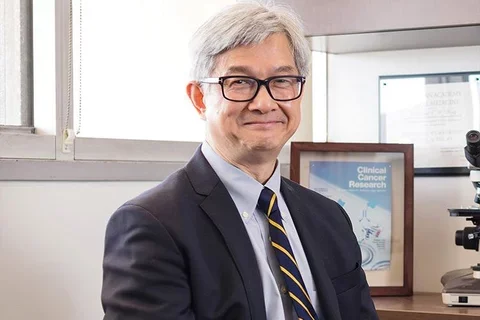David Wong's WLab

Principal Investigator:
Read BioAbout
Imagine a world where a routine visit to the dentist saves your life. Imagine a world where doctors do not have to draw your blood to test if you are sick. Imagine a world where procedures save countless lives and save billions of dollars. The goal of our research is to make this dream a reality. Here at the Wong Lab, we are pioneering research in the usage of saliva as a diagnostic medium for early detection and monitoring of systemic diseases. Additionally, we are focused on the fundamental biology of molecular markers in biofluids in particular their biogenesis, transport, metabolism, and their downstream effect on the pathophysiology of the human body, in health and disease.
Current Projects and Grants
Liquid biopsy has found its way into the cancer lexicon as a reference to tumor biomarkers within blood or other readily accessible biospecimens such as saliva that reflect the presence and biology of cancer. This project interleaves the expertise of lung cancer biologists, clinicians, and biostatisticians with industry engineers, converging on a novel liquid biopsy technology "EFIRM-Liquid biopsy (eLB)" that has already shown high sensitivity detecting circulating DNA mutations in patients with EGFR-mutant lung cancers. To address early lung cancer detection we are developing and validating independent assay for circulating tumor DNA (ctDNA) and microRNA in mutations commonly observed in lung cancer. This integrated platform will be validated in patients with screen- or incidentally- detected lung nodules in the size ranges that are most diagnostically challenging. Our overall research proposition is that blood-based biomarkers using the eLB-Lung Cancer Detection Panel (eLB-LCDP) will inform the accurate and robust classification of nodules as benign or malignant. Additionally, we are examining the unique physical characteristics of ctDNA in plasma and saliva and using state-of-the-art techniques and methods.
Supporting Grants: U01 CA233370 (EFIRM-Liquid Biopsy (eLB): Ultrasensitive ctDNA and miRNA Detection for Early Assessment of Lung Cancer), UH2/UH3 CA206126 (Advancing EFIRM-Liquid Biopsy (eLB) to a CLIA-Certified Laboratory Developed Test (eLB-LDT) for Detection of Actionable EGFR Mutations in NSCLC Patients, and 1R21CA239052 (Ultra-short circulating tumor DNA (uctDNA) for liquid biopsy of non-small cell lung cancer).
Oral cavity squamous cell carcinomas (OCSCC) represent one-third of United States cases of head and neck squamous cell cancers and one-half of worldwide cases. OCSCC is often preceded by oral premalignant mucosal lesions (OPMLs), it is an ideal disease for screening initiatives. The conventional visual and tactile exam (CVTE), coupled with a tissue biopsy, remains the gold standard. However, CVTE and currently available adjunctive screening tests have significant limitations because they cannot reliably differentiate between reactive/inflammatory and OPML. Further, the histologic diagnosis of OPML is an imperfect predictor of malignant transformation as only ~15% of dysplasias progress to OCSCC. The uncertainty of risk of OCSCC progression has created a significant clinical management dilemma – watchful waiting with increased patient psychological and economic burdens vs. unnecessary aggressive surgery with reduced quality of life and compromised daily functions. As such, the development of biofluid-based biomarkers that can predict malignant progression of OPML with a high degree of diagnostic accuracy would address this critical unmet clinical need.
High-throughput molecular technologies have allowed for a greater understanding of numerous disease entities, including OCSCC. However, our understanding of OCSCC progression from an OPML, and the candidate biomarkers associated with this progression remains limited. This is due to a number of factors, including the availability of adequate (both quantity and quality) OPML tissue and paired blood samples. We have a unique, rare opportunity to access such a cohort of well-annotated OPML tissues and matched blood samples to use state-of-art molecular technologies on plasma to generate the first-ever multiomic molecular landscape of OPMLs, address this unmet clinical need and the key to end the devastation of OCSCC.
The long-term goal is to establish a comprehensive biofluid-based platform that can identify high-risk OPML most likely to progress to OCSCC. Our central hypothesis is that OPML contains identifiable and unique plasma biomarkers that can be used for screening and prognostication. These studies are conceptually innovative and likely to result in state-of-the-art risk stratification of OPML. This research will benefit human health by improving our ability to identify high-risk OPML that are most likely to progress to OCSCC, thereby allowing for earlier and potentially more curative interventions while decreasing morbidity and mortality.
Supporting Grants: American Cancer Society PASD-RSG-23-1142089-01-PASD (Novel Liquid Biopsy Biomarkers for Oral Cancer Progression and Recurrence)
Extracellular RNA (exRNA) is an emerging paradigm as endocrine signals in cellular communication, biomarker development, therapeutic applications, and systemic physiology. Our laboratory first reported the existence of a transcriptome and microRNA profile in cell-free saliva, followed by its scientific characterizations and clinical utilities, including biomarker development for molecular oncology applications. Most recently, we have performed RNA-sequencing in cell-free saliva and reported three major types of RNA in saliva (mRNA, miRNA, and snoRNA). We are testing the hypothesis that salivary extracellular RNA (exRNA) can be developed for the clinical detection of human diseases using gastric cancer as a model disease. Additionally, we seek to improve and optimize current methods for salivary-exosome isolation, which have been shown to be the vesicular transporter that houses exRNA cargo.
Supporting Grants: 1UG3/UH3 TR002978 (Acoustofluidic Separation (AFS), Purification and Raman Spectral Fingerprinting of Single EVs: From Cell of Origin to Target Cell and Biofluids), UH2/UH3 TR000923 (Clinical Utility of Salivary Extracellular RNA Biomarkers for Gastric Cancer Detection), and Ronnie James Dio “Stand UP and Shout” Cancer fund.
The objective of this project is to identify epigenetic alterations associated with accelerated oral wound healing phenotype in human oral keratinocytes. Using next-generation bisulfite sequencing, differential transcriptomic analysis, and bioinformatics analysis, we aim to identify the mechanism of oral specific piwi-interacting RNA (oral-piRNAs) in oral keratinocytes. BLAST results demonstrated oral-piRNAs mapping to transposable elements, specifically Alu. Knockdown of oral-piRNAs resulted in altered Alu methylation. Current findings suggest oral-piRNAs as intrinsic factors that modulate molecular pathways in human oral keratinocytes through de novo methylation of Alu elements.
Supporting Grants: R21 DE34146 (The functional role of piRNA in oral wound healing); F30 DE027615 (Oral-piRNAs Enhance Re-epithelialization in Oral Wound Healing).
Early detection of Sjögren’s Disease (SjD) and its precursor autoimmune-Sicca Syndrome (AI- Sicca), are unmet clinical needs. Serum anti-Ro/SSA autoantibodies and biopsy focus score are two key classification criteria of SjD by the 2016 ACR-EULAR 1. SjD is a complex disease. Clinicians provide symptomatic treatment to patients as the symptoms of SjD are similar to other physiological and pathological changes in the body, including menopause, drug side effects and fibromyalgia, amongst others. This leads to a 3-year delay in initial diagnosis from the time the patients first seek medical care. In addition, there is currently no test for the diagnosis of AI-Sicca. In order to address this unmet clinical need, we have developed a saliva-based electrochemical assay, electric field-induced release and measurement (EFIRM), that can screen, earlier detect, and risk assess the onset of SjD, an alternative to the current ELISA blood-based serology assay. Preliminary data demonstrated: 1) EFIRM can directly detect and quantify salivary anti-SSA/Ro52 autoantibodies in SjD patients; 2) Salivary and serum anti-SSA/Ro52 are correlated in SjD and AI- Sicca patients; 3) Salivary anti-Ro52/SSA IgA1 correlates to salivary gland focus scores. This R21 application will test the hypothesis in a large cohort of SjD and AI-Sicca patients that EFIRM, can: 1) detect anti-SSA/Ro52 and anti-SSB/La in the saliva of SjD and AI-Sicca patients, and 2) salivary IgA1 to SSA/Ro52 is associated with salivary gland tissue destruction as measured by focus scores. Furthermore, monomeric versus polymeric forms for IgA1 to salivary SSA/Ro52 can discriminate SjD from AI-Sicca patients. Should this hypothesis be validated, the EFIRM salivary anti-SSA/Ro52 and anti-SSB/La assays can be explored for early detection of SjD and AI-Sicca in a prospective multi-site clinical study, as well as basic science mechanistic pursuits. In addition, saliva monitoring of IgA1 to SSA/Ro52 can be hypothesis tested for monitoring AI-Sicca progression to SjD in a non-invasive sample type (saliva). Three specific aims are proposed for this project. Specific Aim1: Acquire and Characterize Clinical cohorts of SjD, AI-Sicca, and matched control subjects. Specific Aim 2: EFIRM quantitative assessment of anti-SSA/Ro52 and anti-SSB/La in saliva of SjD, AI-Sicca, and Controls. EFIRM SSA/Ro52 and SSB/La autoantibody immunoassays will be performed on 210 SjD, 210 AI-Sicca, and 315 control subjects (blinded and randomized). Hypothesis testing of saliva SSA/Ro52 and SSB/La autoantibodies to discriminate 1) SjD vs AI-Sicca; 2) SjD vs Controls; 3) AI-Sicca vs Controls, and 4) (SjD + AI-Sicca) vs Controls. Specific Aim 3: Quantification of monomeric and polymeric anti-SSA/Ro52 IgA1 in saliva of SjD and AI-Sicca patients.
Supporting Grants: R21 DE033901 (Saliva Anti-SSA/Ro and Anti-SSB/La for Early Detection of Sjögren’s and SICCA Syndromes).
Publications
- 1. Wang Z, Li F, Rufo J, Chen C, Yang S, Li L, Zhang J, Cheng J, Kim Y, Wu M, Abemayor E, Tu M, Chia D, Spruce R, Batis N, Mehanna H, Wong DTW, Huang TJ. Acoustofluidic Salivary Exosome Isolation: A Liquid Biopsy Compatible Approach for Human Papillomavir
- Murillo OD, Thistlethwaite W, Rozowsky J, …Wu C, Wong DTW, Galas DJ, Van Keuren-Jensen K, Patel T, Jones JC, Das S, Cheung KH, Pico AR, Su AI, Raffai RL, Laurent LC, Roth ME, Gerstein MB, Milosavljevic A. exRNA Atlas Analysis Reveals Distinct Extracell
- Wei F, Strom C, Cheng J, Lin C, Hsu C, Guy S, Chia D, Kim Y, Li F, Elashoff D, Gorgan T, Tu M, Wei L, Xian R, Grody W, Su W, Wong D. EFIRM Liquid Biopsy (eLB) for Non-Invasive Early Lung Cancer Assessment. J Mol Diagn. 2018;20(6):738-742. PubMed PMID:
- Li F, Kaczor-Urbanowicz KE, Sun J, Majem B, Lo HC, Kim Y, Koyano K, Rao SL, Kang SY, Kim SM, Kim KM, Kim S, Chia D, Elashoff D, Grogan TR, Xiao X, Wong DTW. Characterization of Human Salivary Extracellular RNA by Next-generation Sequencing. Clin Chem.
- Wei F, Lin CC, Joon A, Feng Z, Troche G, Lira ME, Chia D, Mao M, Ho CL, Su WC, Wong DT. Noninvasive Saliva-based EGFR Gene Mutation Detection in Patients with Lung Cancer. Am J Respir Crit Care Med. 2014;190(10):1117-26. PubMed PMID: 25317990.
Lab Members





Collaborators
- Denise Aberle, MD (UCLA Radiology)
- Eliott Abemayor, MD, PhD (UCLA Otolaryngology / Head and Neck Surgery)
- David Chia, PhD (UCLA Pathology)
- David Elashoff PhD (UCLA Biostatistics)
- Udayan Guha MD, PhD (NCI Clinical Research Center)
- Alexander Hoffmann PhD (UCLA)
- Chung-Liang Ho MD, PhD (National Cheng Kung University, Pathology)
- Tony Huang, PhD (Duke University Biomedical Engineering)
- Kostyantyn Krysan PhD (UCLA Pulmonary Medicine)
- Matteo Pellegrini PhD (UCLA)
- Marilene Wang, MD (UCLA Otolaryngology / Head and Neck Surgery)
- Charles Strom, MD, PhD (Liquid Dx)
- Guy Soo Hoo MD (GLA)
- Yeong-Wook Song MD, PhD (Seoul National University, Rheumatology)
- Jin Kyun Park MD, PhD (Seoul National University, Rheumatology)
- Wu-Chou Su MD, PhD (National Cheng Kung University, Thoracic Oncology)
- Arjan Vissink DMD, MD, PhD (University Medical Center Groningen)
- Hal Scofield MD, Oklahoma Medical Research Foundation (OMRF)
Opportunities
Join our weekly lab meetings and get to know more about what we do!
